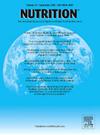Identifying low muscle mass and monitoring body composition changes in newly diagnosed cancer patients: Agreement between multifrequency bioelectrical impedance analysis and computed tomography
IF 3.2
3区 医学
Q2 NUTRITION & DIETETICS
引用次数: 0
Abstract
Objectives
Low muscle mass (MM) is significant in cancer patients, and computed tomography (CT) is considered the reference standard for MM assessment. We investigated the consistency of CT and multifrequency bioelectrical impedance analysis (mBIA) in detecting body composition at baseline and during anticancer treatment and the relationship between MM and malnutrition as well as complications in lung and cervical cancer patients.
Methods
Abdominal CT and mBIA were conducted to assess body composition at baseline for all patients and repeated for patients with cervical cancer after 4 wk of chemoradiotherapy. Concordance was compared by intraclass correlation coefficient and Bland–Altman plots. Receiver operating characteristic analysis was used to assess the diagnostic efficacy of mBIA for low MM. Correlation analysis was conducted to assess the relationship between MM and Nutritional Risk Screening 2002 and Global Leadership Initiative on Malnutrition. Furthermore, we assessed whether there was a difference in the incidence of chemoradiotherapy side effects in the low MM group derived by CT or mBIA.
Results
A total of 77 cervical and 73 lung cancer patients were enrolled. mBIA showed fair discriminative capacity (area under the curve = 0.651) for detecting low MM, the concordance of skeletal MM and visceral fat area between CT and mBIA was good (intraclass correlation coefficient = 0.712 and 0.698, respectively), and mBIA and CT had consistent observations of muscle and fat changes (P = 0.051 and 0.124, respectively). There was no difference in the incidence of chemoradiotherapy side effects in the low MM group compared with controls regardless of whether derived by CT or mBIA (P > 0.05). MM was correlated with Nutritional Risk Screening 2002 and Global Leadership Initiative on Malnutrition but showed unsatisfactory prediction of malnutrition (area under the curve <0.7).
Conclusions
mBIA- and CT-derived body composition was highly correlated, and agreement was reached on body composition changes during treatment.
识别新诊断癌症患者的低肌肉质量并监测其身体成分变化:多频生物电阻抗分析与计算机断层扫描之间的一致性
目的 低肌肉质量(MM)对癌症患者的影响很大,而计算机断层扫描(CT)被认为是评估低肌肉质量的参考标准。我们研究了 CT 和多频生物电阻抗分析(mBIA)在检测肺癌和宫颈癌患者基线和抗癌治疗期间身体成分的一致性,以及 MM 与营养不良和并发症之间的关系。通过类内相关系数和Bland-Altman图比较一致性。接收者操作特征分析用于评估 mBIA 对低度 MM 的诊断效果。我们进行了相关性分析,以评估 MM 与《2002 年营养风险筛查》和《全球营养不良领导倡议》之间的关系。此外,我们还评估了通过 CT 或 mBIA 得出的低 MM 组化疗副作用的发生率是否存在差异。651),CT 和 mBIA 对骨骼 MM 和内脏脂肪面积的一致性良好(类内相关系数分别为 0.712 和 0.698),mBIA 和 CT 对肌肉和脂肪变化的观察结果一致(P 分别为 0.051 和 0.124)。低MM组与对照组相比,无论通过CT还是mBIA得出的结果如何,化放疗副作用的发生率均无差异(P >0.05)。MM与《2002年营养风险筛查》和《全球营养不良领导倡议》相关,但对营养不良的预测效果不理想(曲线下面积为0.7)。
本文章由计算机程序翻译,如有差异,请以英文原文为准。
求助全文
约1分钟内获得全文
求助全文
来源期刊

Nutrition
医学-营养学
CiteScore
7.80
自引率
2.30%
发文量
300
审稿时长
60 days
期刊介绍:
Nutrition has an open access mirror journal Nutrition: X, sharing the same aims and scope, editorial team, submission system and rigorous peer review.
Founded by Michael M. Meguid in the early 1980''s, Nutrition presents advances in nutrition research and science, informs its readers on new and advancing technologies and data in clinical nutrition practice, encourages the application of outcomes research and meta-analyses to problems in patient-related nutrition; and seeks to help clarify and set the research, policy and practice agenda for nutrition science to enhance human well-being in the years ahead.
 求助内容:
求助内容: 应助结果提醒方式:
应助结果提醒方式:


